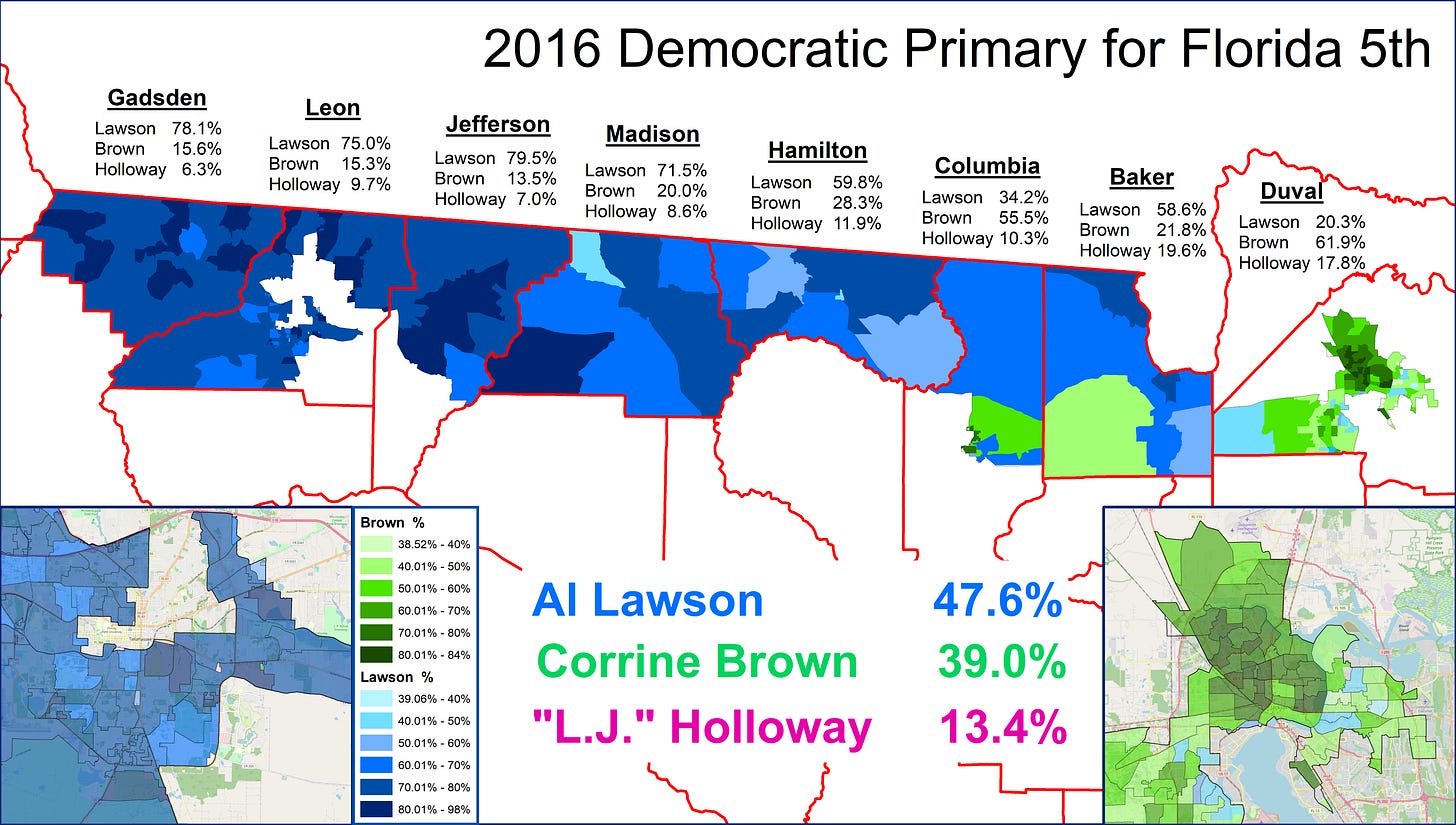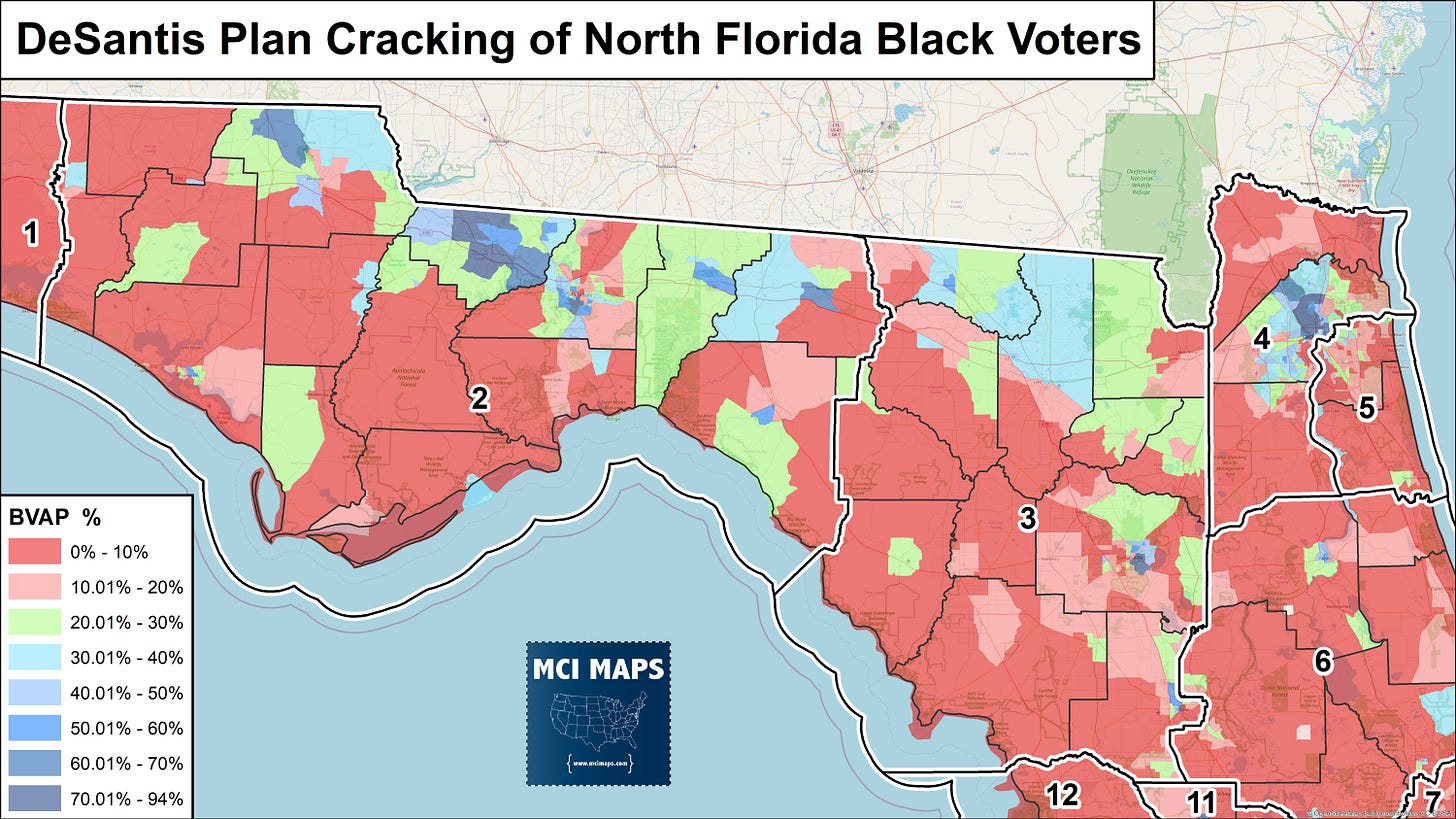Yesterday, on September 2nd, Florida Second Judicial Circuit Judge J. Lee Marsh, a Rick Scott appointee, struck down Florida’s Congressional map. Specifically, the Judge struck down the North Florida portion of the map, which was being sued over for the elimination of the Black-access 5th district.
This decision came after a lawsuit over the Congressional map was narrowed to focus specifically on the 5th district, a 2016-2022 seat that connected Black voters from Tallahassee to Jacksonville. While lawmakers had initially planned to keep such a district in place, arguing it was mandated by Florida’s Fair Districts amendments rules for preserving minority districts, Governor Ron DeSantis vetoed the plan and ordered a “race-neutral” map in North Florida.
In just recent weeks I have covered the developments in this trial. Read these links for more background, as I intend this post to focus on ruling itself.
Issue #123: The state and plaintiffs agree to limit the redistricting lawsuit just to North Florida. I delve into why the case was changed from being about the whole state to just North Florida and I offered more comprehensive history on Florida’s redistricting saga.
Issue #125: I look at how the one-day hearing before Judge Marsh went. The tone of the judge indicated this ruling was very likely. The state struggled to defend the elimination of the old 5th.
With Marsh’s decision, the legislature is ordered to redraw North Florida to bring back a Black-performing seat. The Tallahassee to Jacksonville (east - west) configuration was sited by both parties as an acceptable remedy, with a draft from the House from 2022 being specifically highlighted.
However, the state is planning an appeal, arguing such a plan would violate the federal rules around racial gerrymandering. The stipulation agreement I discuss in Issue #123 means appeals should go right to the Florida Supreme Court. The goal is to get a final ruling by the end of the year, giving the legislature time to draw a new map if the lose that appeal.
Lets delve into Marsh’s ruling and I’ll offer thoughts on how things might go with the top Florida Court.
Judge Marsh’s Ruling
In his order, Judge Marsh laid out the history of the 2022 redistricting process, which included the legislature initially agreeing to preserve an east-west seat. That plan only came into question when Governor DeSantis intervened, demanding an end to the race-conscious North-Florida seat. The ruling lays out the issue at play - the Fair District’s rules against retrogression of minority-performing seat. In short, once a district is in use and performing for a minority voter block, it must be preserved if possible (especially baring demographic changes).
The Facts of the Benchmark 5th
The order goes into if the old 5th, known as “The Benchmark” - was indeed a minority performing seat. The order lays out Florida’s process for degerming such performance. Here is where Functional Analysis, as the court lays out, comes into play. The court lays out the three key criteria for such analysis.
Whether the minority group votes cohesively
Whether the minority candidate of choice is likely to prevail in the relevant primary
Whether the minority candidate of choice is likely to prevail in the general election
So, how did the old Florida 5th, the one that existed from 2016-2022 and was Represented by Al Lawson, look when functional analysis was applied?
With this breakdown, Judge Marsh agrees with the plaintiffs that the 5th was a performing Black seat, and hence covered by the Fair Districts amendments. The last 3 lines are very important to emphases as well.
On Point G - Cohesion
The issue around voter cohesion has come up many times. Conservatives on twitter have tried to claim that the geographic divide in Democratic primaries means Black voters are not cohesive. As I delved into with my deep-dive into the elections of Al Lawson, the races for the 5th had notable geographic divides. Notably, the Tallahassee-based Lawson had Jacksonville voters/politicians looking for one of their own to represent the district.
Results like this are used to say “see Black voters are not cohesive in the district.” However, this type of geographic vying for power is not how cohesion is studied. A better example of cohesion would be from my look at DeSantis trying to draw 5 Hispanic-majority seats. In that, I highlighted one of the seats linked Cuban and South American Hispanics that had little voting cohesion in general or primary elections.
Cohesion has been used to test many types of districts. An effort to draw a majority non-white district in Hardee County was rejected because it showed the Hispanic and Black populations, which would have to vote as a block to control the proposed-seat, did not have strong voter cohesion.
In the case of the 5th, the data showed that the primary debate over city-control did not prevent Black voters from dominating the primary. In addition, the the divide in the primary did not last into the general election. Black voters showed clear cohesion in the 5th district.
Points H & I - Racial Polarization
The results of elections in the Benchmark 5th showed that voting in the North Florida region was heavily racially polarized. Judge Marsh delves into this issue and case law in North Florida even more later in the order. The polarization in North Florida mirrors what we see in many parts of Alabama as well, which has been dealing with its own redistricting battle.
The Current Districts
The order also lays out how none of the current North Florida seats perform for Black candidates. The current 2nd, 3rd, 4th, and 5th were all sited as not having large enough Black populations to elect a candidate of their choice. This is no shock considering the districts all split up North Florida’s Black population.
Based on these factors, the Florida 5th’s elimination clearly violated Fair Districts. The state’s main defense has been complying with federal law. However, the Secretary of State has an additional defense that the House and Senate do not appear to sign on with. Lets talk about the SOSs position and Marsh’s response
Secretary Byrd’s Defense
It is especially notable that the Secretary of State is carrying out a very different defense than the legislature does. The SOS, which is run by former far-right State Rep Cord Byrd, is essentially claiming that the 5th deserved no protection under the Florida constitution either. This relies on the belief that a district must be 50%+ minority and match with conditions laid out in Thornburg v Gingles. Judge Marsh rejected this.
So why is Byrd’s position incorrect? The court lays out the different methods of ensuring minority protection in redistricting. The issue lies on the difference between non-diminishment and non-dilution; two items both in Florida’s Constitution. Yes these are different things, and that difference is important. Let me lay it out
Non-Dilution: This provision of Fair Districts was copied from Section 2 of the Voting Rights Act. Section 2 and subsequent Court cases, like Thornburg v Gingles, laid out when drawing a minority district may be mandatory. Conditions of this including racially polarized voting, minority voter cohesion, and the ability to draw a 50%+ minority seat. Again it must be noted this is important for drawing a NEW seat, not preserving an old one. For that, we look to the next item.
Non-Diminishment: This provison of Fair Districts was copied from Section 5 of the Voting Rights Act. This section mandates the state not eliminate districts that historically have performed for a minority voters by electing their candidate of choice. This does not just kick in if a district is/can be over 50% minority, but rather if the seat performs via functional analysis.
The Secretary of State spends its defense acting as if the old Florida 5th was governed by non-dilution principles However, as the court points out, it is actually non-diminishment. We had the 5th performing for Black voters already, it was not a NEW district being created. Hence its governed by different criteria. As Judge Marsh says in his opinion.
Non-dilution and non-diminishment are different requirements, seeking to guard against different harms.
And to re-iterate, what is that non-diminishment criteria?
Whether the minority group votes cohesively
Whether the minority candidate of choice is likely to prevail in the relevant primary
Whether the minority candidate of choice is likely to prevail in the general election
The benchmark 5th met all three of these items.
Judge Marsh also noted that Florida’s Supreme Court has already made it clear that Thornburg and the 50%+ rule are not the only thing that Governors Florida law. In its 2022 decision signing off on the state’s legislative maps, the court highlighted state legislative districts that were not majority-Black but did perform for Black voters and were hence protected under the Fair Districts rules.
Judge Marsh harshly rejected the Secretary of State’s argument that Section 2 and Gingles are what is at play here.
The State’s Defense Standing
One other major issue about the case is also brought up. I think it is significant, as it may give the conservative Florida Supreme Court an a way to uphold the ruling while not re-litigating Fair Districts.
In the filings from the plaintiffs, and in the arguments made before the court, the coalition made an important legal point. The state’s defense, which is that bringing back the old 5th would violate the 14th Amendment, may not have proper standing. In the petitions, the plaintiffs pointed out that a lawsuit over a district, claiming it violates the 14th amendment by only being drawn based on race, needs to be from voters in the district. A voter being effected by the district lines is the one who has standing and cause to sue; not state officials.
For example, when the lawsuit that struck down the 1992 version of CD3 was filed, it was done so by voters themselves.
And as I have discussed before, a district like that is very likely to be struck down, as its shape is entirely about race. That district was an important example of the illegal act of race-predominance in map drawing. Map-makers can draw race-conscious maps, aka ones that consider racial demographics but aren’t 100% dictating the lines. The old 3rd was a good example of district who’s borders could ONLY be explained by race, something the courts have not allowed.
The state is arguing that any remedy FL-05 would be a race-predominant map. This of course ignores that the 2016 version help up to court challenge. Either way, Judge Marsh agrees with the plaintiffs that the state has NO STANDING to make this claim. Marsh lays out a few key reasons.
The Supreme Court of Florida upheld the benchmark 5th district, which means per current precedent, it did not violate the 14th amendment.
Lawsuits over racial gerrymandering via the 14th amendment require looking at an actual district being used. While the state can claim any east-west 5th would violate the 14th amendment, the way for that to be determined would be a court to actually strike down such a seat. No district currently exists, nor as one similar to it been struck down in the past.
Public officials doctrine: This Florida rule means public officials cannot challenge the constitutionality of their legal duties in court. So if Fair Districts gives them legal mandates (non-diminishment) - these officials are not allowed to sue in court to question that mandate.
Personal Harm: Judge Marsh also agreed with the plaintiffs that the state cannot question the constitutionality of a proposed district because it suffers no personal harm. The US Supreme Court has left it to voters in an alleged racial gerrymander to file suit, as they are the ones who would be “harmed” by the lines. This also means a voter in Miami, for example, cannot challenge districts in North Florida. This principle also applies to Governments.
This issue of standing may be an important way for the conservative Florida Supreme Court to side with Judge Marsh and order an east-west 5th. This would be a rebuke of DeSantis, but a more minor one, essentially saying the state’s argument has no standing. This would leave the door open to a future suit. A new map would have to be passed, with a voter then suing over its implementation. However, that delay pushes the issue to another day, and many hurdles can keep it away from the top court again.
If the Florida Supreme Court wants an “out” - then this is the best way.
Race-Predominance
Judge Marsh also looks at the claims that any east-west 5th would be federally unconstitutional due to race-predominance. The state’s defense spent a good deal of time talking about the old 5th, which indeed has many jagged lines in places like Jacksonville. However, in my recent articles I have gone into why these lines looked this way and the then-legislature’s failure to clean the borders up. Regardless, Judge Marsh does not focus on the old 5th, but rather the house-passed proposal that was eventually vetoed by DeSantis. For context, below is how the 2016 benchmark 5th compares to the House’s proposed (vetoed) lines.
As this map shows, the House’s plan from last year evened out many lines and stuck to major roadways and clear boundaries to craft the lines. Marsh agreed with the plaintiff’s argument that only 2% of the borders for the house-passed CD5 did not follow major geographic and political boundaries; well above many other districts in the state.
Judge Marsh also found that the district’s long shape did not mean it was woefully un-compact. First off, the compactness rule is SECONDARY to several other considerations, including minority protections. That said, compared to other versions of a North Florida minority seat (see that 1992 district) - this plan is reasonable compact, with its length also influenced by the rural population of the region. As I covered in my last issue, Florida has several districts with long drive times as well. The 5th would not be especially unique.
Discriminations and the State Interest
The final point made by Judge Marsh was the history of discriminations in Florida and the compelling state interest to remedy that. One key part of race-conscious redistricting is trying to right a wrong of past and current discrimination. The racially-polarized voting we see in the functional analysis goes hand in hand with a history of discriminations and lawsuits in North Florida. This section of the ruling was so important I copied it entirely here.
The order lays out several North Florida cases, which I’ve highlighted, that support the narrative that Black voters in North Florida have faced hardship when it comes to representation and voting strength. This reality flies in the face of the Secretary of State claiming that discriminations in North Florida is overblown.
This type of argument makes sense from a Secretary of State that has been engaged in racist intimidation on the House floor and who’s wife is a January 6th defender and a Q-anon sympathizer.
This argument from the Byrd Klan comes at the same time Jacksonville reels from a racist mass-shooting perpetuated by a guy with a swastika painted on his gun. Just yesterday Florida dealt with Neo-Nazis waving swastika AND DeSantis flags outside of Disney world.
It should also be noted that when DeSantis came to speak at the site of the Jacksonville shooting, he was booed by the public. This photo of Democratic State Rep Angie Nixon staring daggers into the Governor speaks volumes.
And to be clear, there is ZERO reason for Nixon or anyone in that crowd to give DeSantis respect. His administration has worked to roll-back teaching about slavery or paint it as beneficial, he has fought against minority districts, and courts a rabid far-right voting block that waves NAZI signs.
As far as DeSantis is concerned, there is no racism in Florida. His Secretary of State parrots this nonsense in the courts. In his ruling, Judge Marsh found that the history in Florida clearly adds to the state interest of redrawing the map.
Conclusion and Next Steps
As I laid out at the top of this post, appeals from the state should go right to the Florida Supreme Court. This means a few months before we likely have a final resolution. However, the plaintiffs and North Florida Black voters are in a good position by having an affirmative ruling at the trial court level. The Florida Supreme Court could weigh in heavily, either striking down Fair Districts as federally unconstitutional OR siding against the Governor on a high-profile matter. The court could also take the out offered by standing, which in practice would lead to the east-west 5th coming back.
We will see how things develop in the comings weeks and months. However, the fight is not won just yet.













Good stuff as always- Matt what’s your Patreon info? I’d like contribute.